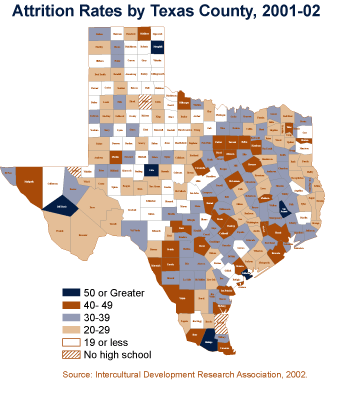• by Roy L. Johnson, M.S. • IDRA Newsletter • October 2002 • 

Two of every five students of the freshman class of 1998-99 left school prior to graduating from a Texas public high school in 2001-02. The Intercultural Development Research Association (IDRA) calculates Texas school attrition rates each year. This year, down one percentage point from last year, the percent of students lost from public school enrollment has remained relatively unchanged over the past eight years at or about 40 percent.
The latest IDRA attrition study, released in October 2002, shows that 143,175 students in the Texas class of 2002 were lost from enrollment due to attrition. Between the 1985-86 and 2001-02 school years, nearly 2 million students have been lost from public school enrollment with estimated cumulative costs of public school dropouts in the state of Texas in excess of $488 billion. The average cost per student dropout is estimated to be $265,268. Overall, the statewide attrition rate has ranged from a low of 31 percent in 1988-89 and 1989-90 to a high of 43 percent in 1996-97.
In 1986, IDRA conducted Texas’ first comprehensive statewide study of high school dropouts. Using a high school attrition formula, IDRA’s inaugural study found that 86,276 students had not graduated from Texas public high schools, costing the state $17 billion in forgone income, lost tax revenues, and increased job training, welfare, unemployment and criminal justice costs (Cárdenas, Robledo and Supik, 1986). IDRA’s latest study spans a 17-year time period from 1985-86 through 2001-02 and documents the number and percent of public school students who leave school prior to graduation.
IDRA is the only organization to annually compute attrition rates since 1985-86 and is the only state-level group that does so using consistent definitions and calculation methods (Robledo Montecel, 2002). The inaugural study in 1986 was the state’s first major effort to assess the school holding power of Texas public schools, the measure of schools’ performance to keep students enrolled in school and learning until they graduate.
Using its high school attrition formula, IDRA collected and used high school enrollment data from the Fall Membership Survey of the Texas Education Agency (TEA) to compute countywide and statewide attrition rates by race-ethnicity and sex. The enrollment data from special school districts (military schools, state schools, and charter schools) were excluded from the analyses since they are likely to have unstable enrollments and/or lack a tax base to support school programs.
During the fall of each year, school districts are required to report information to TEA via the Public Education Information Management System (PEIMS) for all students and grade levels. IDRA’s attrition studies involve the analysis of ninth grade enrollment figures and 12th grade enrollment figures three years later. This period represents the timespan during which a ninth grade student would be enrolled in high school prior to graduation.
Historical Attrition Data
Historical statewide attrition rates and numbers of students lost to attrition are categorized by race and ethnicity and by gender. General conclusions follow.
The overall attrition rate has increased by 18 percent from 1985-86 to 2001-02. The percentage of students who left high school prior to graduation was 33 percent in 1985-86 and was 39 percent in 2001-02. Over the past 17 years, attrition rates have fluctuated between a low of 31 percent in 1988-89 and 1989-90 to a high of 43 percent in 1996-97.
Numerically, 143,175 students were lost from public high school enrollment in 2001-02 as compared to 86,272 in 1985-86. From 2000-01 to 2001-02, the overall attrition rate declined by 2.5 percent.
The overall attrition rate was less than 40 percent in 2001-02 for the first time in eight years. Between 1994-95 and 2000-01, the overall attrition rate ranged from a low of 40 percent to a high of 43 percent. In 2001-02, the overall attrition rate was 39 percent representing the lowest rate since 1992-93.
The gaps between attrition rates of Hispanic students and Black students and those of White students have widened since 1985-86. Hispanic students and Black students have had considerably higher attrition rates than White students. From 1985-86 to 2001-02, attrition rates of Hispanic students increased 13 percent. During this same period, the attrition rates of Black students increased by 35 percent. Attrition rates of White students declined by 3.7 percent. Hispanic students have higher attrition rates than either White students or Black students.
From 1985-86 to 2001-02, Native American students and Asian/Pacific Islander students had a decline in their attrition rates. Native American students had a decline of 36 percent in their attrition rates, while Asian/Pacific Islander students had a decline of 58 percent.
The historical attrition rates for Hispanic students and Black students have been typically higher than the overall attrition rates. For the period of 1985-86 to 2001-02, students from ethnic minority groups account for two-thirds of the estimated 1.8 million students lost from public high school enrollment. Hispanic students account for nearly half (48.5 percent) of the estimated 1.8 million students lost to attrition. Black students account for 17.3 percent of all students lost from enrollment due to attrition over the years, and White students account for 32.8 percent of students lost from high school enrollment over time. Attrition rates for White students and Asian/Pacific Islander students have been typically lower than the overall attrition rates.
The attrition rates for males have been higher than those of females. Between 1985-86 and 2001-02, attrition rates for males have increased by 22.9 percent. Attrition rates for females have increased by 9.4 percent. Longitudinally, males have accounted for 56.3 percent of students lost from school enrollment, while females have accounted for 43.7 percent.
On the average, nearly 119,000 students do not graduate each year, costing the state of Texas in excess of $488 billion. Costs associated with school dropouts (forgone income; lost tax revenues; and increased job training, welfare, unemployment and criminal justice costs) have continued to escalate. Between 1985-86 and 2001-02, the estimated cumulative costs of public school dropouts in the state of Texas were in excess of $488 billion.
Latest Attrition Results


Two of every five high school students were lost from high school enrollment prior to graduation. Two of every five students (39 percent) enrolled in the ninth grade in Texas public schools during the 1998-99 school year failed to reach the 12th grade in 2001-02. An estimated 143,175 students, or about 39 percent of the 1998-99 freshman class, were lost from public school enrollment by 2001-02.
Hispanic students and Black students were more likely than White students to be lost from high school enrollment in 2001-02. Fifty-one percent of Hispanic students and 46 percent of Black students were lost from public school enrollment, compared to 26 percent of White students. Hispanic students were two times more likely than White students to leave school before graduation, while Black students were 1.8 times more likely than White students to leave school before graduation.
From 2000-01 to 2001-02, four racial-ethnic groups had a decline in attrition rates: Native American students had a decline from 42 percent to 29 percent; Asian/Pacific Islander students had a decline from 20 percent to 14 percent; White students had a decline from 27 percent to 26 percent, and Hispanic students had a decline from 52 percent to 51 percent. Attrition rates for Black students remained unchanged at 46 percent.
Hispanic students made up the highest percentage of students lost from public high school enrollment in 2001-02. Over half (53.6 percent) of the students lost from school enrollment were Hispanic. White students comprised 27.9 percent of the students lost from enrollment, and Black students comprised 17.4 percent.
Males were more likely to be lost from enrollment than females. For 2001-02, 43 percent of males were lost from public high school enrollment, compared to 35 percent of females. Males constituted 57.8 percent of all students lost from public school enrollment compared to 42.2 percent for females.
Overall, there has been an 18 percent increase in the attrition rate since 1985-86. The percent of students lost from public high school enrollment has increased by 18.2 percent between the 1985-86 school year and the 2001-02 school year. The number of students lost through attrition per school year has increased from 86,276 in 1985-86 to about 143,175 in 2001-02.
Conclusions
IDRA’s attrition analyses show that there has been little change in the percent of Texas high school students who are lost from high school enrollment in the last several years. Two out of every five students from freshman classes continue to leave school prior to graduation. In an era of ever growing rhetoric of school accountability and school success, the ability and performance of schools to keep students in school until they graduate is questionable and below standard.
The 17-year cumulative effect of hundreds of thousands of students leaving school each year prior to graduation has translated into 1.8 million students without a diploma and an estimated cost of $488 billion dollars. The challenge of increasing school holding power must become a mandate in our state. We must ensure that our students progress through our schools and graduate with a high school diploma to be educationally, socially and economically responsible.
Resources
Cárdenas, J.A., and M. Robledo, J. Supik. Texas School Dropout Survey Project: A Summary of Findings (San Antonio, Texas: Intercultural Development Research Association, 1986).
Robledo Montecel, M. “Texas Needs Diplomas, Not Delusions,” IDRA Newsletter (San Antonio, Texas: Intercultural Development Research Association, 2002).
U.S. Department of Education, Office of Educational Research and Improvement, National Center for Education Statistics. Documentation to the NCES Common Core of Data, Local Education Agency Universe Dropout File: School Year 1999-00.
Roy L. Johnson, M.S., is the director of the IDRA Division of Evaluation Research. Comments and questions may be directed to them via e-mail at feedback@idra.org.
[©2002, IDRA. This article originally appeared in the October 2002 IDRA Newsletter by the Intercultural Development Research Association. Permission to reproduce this article is granted provided the article is reprinted in its entirety and proper credit is given to IDRA and the author.]


